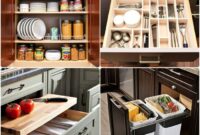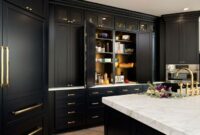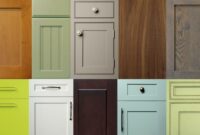Custom Kitchen Cabinets transform your cooking space from functional to fabulous. This guide explores everything from choosing the perfect wood type and door style to understanding the manufacturing process and budgeting for your dream kitchen. We’ll delve into design considerations, hardware selection, and the various finishes available, ensuring you’re equipped to make informed decisions throughout your renovation journey.
Get ready to create a kitchen that’s uniquely yours.
Whether you’re envisioning sleek modern cabinets or rustic farmhouse charm, the possibilities are endless with custom design. Understanding the different construction methods, materials, and available styles is key to achieving your desired aesthetic and functionality. This guide will walk you through each step, helping you navigate the choices and create a kitchen that perfectly reflects your personal style and culinary needs.
Types of Custom Kitchen Cabinets
Choosing custom kitchen cabinets is a significant investment, impacting both the functionality and aesthetic appeal of your kitchen for years to come. Understanding the different types of materials, construction methods, and door styles available is crucial for making informed decisions that align with your budget and design preferences. This section explores these key aspects to help you navigate the process.
Cabinet Construction Materials
The material chosen significantly influences the durability, cost, and overall look of your cabinets. Several options exist, each with its own set of pros and cons.
| Material | Durability | Cost | Aesthetic Qualities |
|---|---|---|---|
| Solid Wood (e.g., Oak, Cherry, Maple) | High; durable and long-lasting with proper care. | High; most expensive option. | Classic, warm, and can be stained or painted various colors; offers rich grain patterns. |
| Wood Veneer | Moderate; less durable than solid wood but more durable than laminate. | Medium; less expensive than solid wood but more expensive than laminate. | Offers the look of solid wood at a lower cost; grain patterns are consistent. |
| Laminate | Low to Moderate; susceptible to chipping and scratches but easy to clean. | Low; most affordable option. | Wide variety of colors and patterns available; easy to maintain. |
| MDF (Medium-Density Fiberboard) | Moderate; prone to moisture damage if not properly sealed. | Medium-Low; generally more affordable than solid wood. | Smooth surface, accepts paint well, can be used with various finishes. |
Framed vs. Frameless Cabinet Construction
Two primary construction methods define custom kitchen cabinets: framed and frameless.Framed cabinets feature a face frame—a structural border around the cabinet box—to which the doors are attached. This creates a more traditional look. Examples include cabinets with raised panel doors set within the frame. Advantages include increased durability and sturdiness, better ability to hide imperfections in the box construction, and a more classic aesthetic.
Disadvantages include less storage space due to the frame and potentially higher cost.Frameless cabinets, also known as European-style cabinets, lack a face frame. Doors are mounted directly to the cabinet box. Examples are common in modern kitchens. Advantages include maximizing storage space and offering a sleeker, more contemporary look. Disadvantages include the potential for showing imperfections in the cabinet box construction and possibly reduced durability compared to framed cabinets.
Cabinet Door Styles
The style of your cabinet doors significantly impacts the overall kitchen design. Several popular options exist:
The choice of door style significantly impacts the overall aesthetic of your kitchen. Consider the following options:
- Shaker: Simple, clean lines with a recessed center panel. Offers a timeless appeal suitable for various kitchen styles, from traditional to contemporary.
- Slab: Flat, minimalist doors with no ornamentation. Creates a modern, sleek look, ideal for contemporary or minimalist kitchens.
- Raised Panel: Features a raised center panel, often with decorative molding. Provides a more traditional and ornate look, well-suited for classic or transitional kitchens.
- Beadboard: Features vertical or horizontal grooves resembling beadboard paneling, offering a cottage or farmhouse style aesthetic.
- Glass-Front: Incorporates glass panels in the doors, allowing for display of decorative items within the cabinets. Adds visual interest and works well with open shelving concepts.
Design and Planning Considerations
Designing custom kitchen cabinets is more than just choosing pretty doors; it’s about creating a space that’s both beautiful and functional. Careful consideration of layout, workflow, and hardware choices will significantly impact your kitchen’s efficiency and overall aesthetic appeal. This section explores key design and planning elements to help you make informed decisions.
Kitchen Layout and Workflow
The layout of your kitchen directly affects how efficiently you can prepare and cook meals. A well-designed layout minimizes wasted steps and maximizes workspace. Popular layouts include the galley kitchen (ideal for smaller spaces), the L-shaped kitchen (offering ample counter space), the U-shaped kitchen (providing extensive storage and workspace), and the island kitchen (great for entertaining and additional prep space).
Cabinet placement is crucial in optimizing these layouts. For instance, in a galley kitchen, placing base cabinets along both walls with upper cabinets above provides maximum storage, while leaving sufficient counter space between for food preparation. In a U-shaped kitchen, strategically placing the sink, stove, and refrigerator in a triangular arrangement (the “work triangle”) promotes efficient movement between these key areas.
Improper placement, such as placing the refrigerator far from the prep area, can significantly reduce efficiency.
The Role of Cabinet Hardware
Cabinet hardware, while seemingly minor, significantly influences the overall design and feel of your kitchen. Handles, knobs, and pulls come in various styles, materials, and finishes. For example, sleek, minimalist bar pulls create a modern look, while ornate knobs add a touch of traditional elegance. Materials range from brushed nickel and stainless steel for a contemporary feel to antique brass or copper for a rustic or vintage aesthetic.
The choice of hardware should complement the overall style of your kitchen and cabinets. Consider the size and shape of the hardware in relation to the cabinet doors and drawers; oversized hardware on small cabinets can look disproportionate, while small hardware on large cabinets might appear insignificant.
Sample Kitchen Layout
Let’s imagine a medium-sized kitchen with an L-shaped layout. Along one wall, we’ll install a 36-inch-wide refrigerator cabinet, followed by a 30-inch-wide sink base cabinet with a 12-inch-wide dishwasher cabinet next to it. Above the sink, we’ll have a 36-inch-wide upper cabinet for dishes and glasses. Continuing along this wall, we’ll place a 36-inch-wide pantry cabinet for extra storage.
The adjacent wall will feature a 36-inch-wide range cabinet with a 30-inch-wide base cabinet on either side for additional prep space. Above the range, a 36-inch-wide range hood cabinet will add functionality and style. Above the prep space cabinets, we’ll have matching 30-inch upper cabinets. This design optimizes workflow by placing the refrigerator, sink, and stove in a close proximity, forming an efficient work triangle.
The ample storage and counter space cater to the needs of a family. We could incorporate glass-front upper cabinets in a section to display attractive dishes or glassware, adding a touch of elegance. The hardware throughout would be sleek, brushed nickel pulls to maintain a modern, clean look.
The Custom Cabinet Manufacturing Process
Creating custom kitchen cabinets is a multifaceted process, requiring precision, craftsmanship, and attention to detail. From the initial design consultation to the final installation, several crucial steps ensure the cabinets meet the client’s exact specifications and expectations. This process blends artistic vision with meticulous manufacturing techniques to produce functional and beautiful kitchen storage solutions.The journey begins with a thorough consultation where the client’s needs, style preferences, and budget are discussed.
Detailed measurements of the kitchen space are taken, and design concepts are developed, often using computer-aided design (CAD) software to visualize the final product. Once the design is finalized, detailed shop drawings are created, serving as blueprints for the manufacturing process. These drawings specify dimensions, material types, finishes, and hardware selections.
Cabinet Construction Techniques
Cabinet construction employs a variety of techniques to ensure durability and aesthetic appeal. Joinery methods, such as dowel joints, mortise and tenon joints, and dado joints, are crucial for creating strong and stable cabinet frames. Dowel joints, for example, use precisely placed dowels to join two pieces of wood, offering strength and simplicity. Mortise and tenon joints, a more traditional approach, involve creating interlocking pieces, resulting in exceptional strength and durability.
Dado joints, on the other hand, are created by cutting a groove into one piece of wood to receive another, offering a clean and sturdy connection. The choice of joinery method depends on the design complexity, desired strength, and aesthetic preferences.Finishing processes are equally important. After construction, cabinets are often sanded smooth, then primed and painted or stained, depending on the desired finish.
Multiple coats of paint or stain may be applied, each followed by sanding to achieve a smooth, even surface. A protective topcoat is typically applied to enhance durability and resistance to scratches and moisture. Various finishes, from high-gloss lacquers to matte stains, offer diverse aesthetic options.
Local Cabinet Maker vs. Large Manufacturer
The decision to commission custom cabinets from a local cabinet maker or a large manufacturer involves weighing several factors. Each option presents distinct advantages and disadvantages:
- Local Cabinet Maker:
- Advantages: Greater personal attention to detail, higher level of craftsmanship, potential for more unique designs, direct communication and easier modifications during the process, often using locally sourced materials supporting the local economy.
- Disadvantages: Potentially higher cost, longer lead times, limited production capacity, might lack the same range of material options offered by larger manufacturers.
- Large Manufacturer:
- Advantages: Potentially lower cost, shorter lead times due to economies of scale, wider selection of materials and finishes, established quality control processes.
- Disadvantages: Less personalized service, potential for less attention to detail, standardized designs, less flexibility for design modifications, may utilize mass-produced components impacting overall quality.
Cabinet Finishes and Hardware
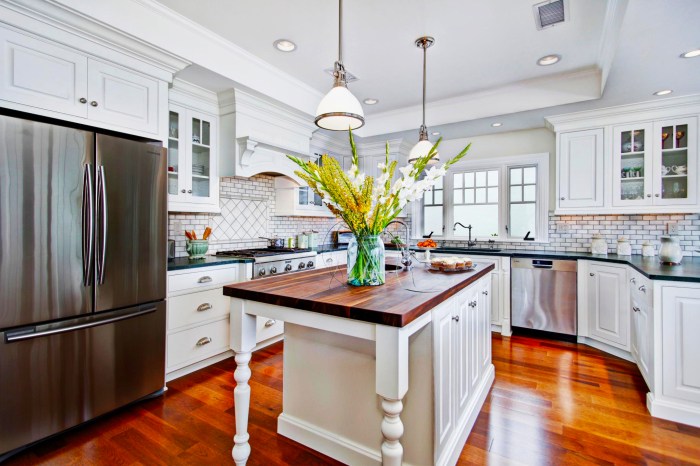
Source: royhomedesign.com
Choosing the right finishes and hardware for your custom kitchen cabinets is crucial for both the aesthetic appeal and the longevity of your investment. The options available are vast, offering a wide range of styles, durability levels, and price points to suit any taste and budget. Careful consideration of these elements will ensure your kitchen reflects your personal style and remains functional for years to come.
Cabinet Paint and Stain Finishes
The finish you select significantly impacts the look, feel, and maintenance of your cabinets. Paint and stain offer distinct advantages and disadvantages, influencing both the visual effect and the practical aspects of your kitchen.
- Matte Paint: Offers a sophisticated, understated look, hiding imperfections well. However, it’s more prone to showing fingerprints and scratches than other finishes and requires more frequent cleaning.
- Eggshell Paint: A slightly more durable option than matte, offering a subtle sheen and good stain resistance. It’s a good compromise between durability and a soft appearance.
- Satin Paint: More durable than matte or eggshell, with a smooth, low-luster finish that is relatively easy to clean. It’s a popular choice for its balance of beauty and practicality.
- Semi-Gloss Paint: Offers excellent durability and stain resistance, making it ideal for high-traffic areas. Its slight sheen makes it easy to wipe clean, but it can highlight imperfections.
- High-Gloss Paint: Provides a dramatic, reflective surface that adds a modern touch. It is very durable but shows every imperfection, requiring meticulous cleaning and maintenance.
- Stain Finishes: Show the natural wood grain, offering a warm and classic aesthetic. Stain finishes are generally more durable than paint, but they require more careful maintenance to prevent scratches and water damage. Different stain colors and application techniques can significantly alter the final appearance.
Cabinet Hardware Selection
Cabinet hardware is more than just functional; it’s a key design element that can dramatically influence the overall style of your kitchen. The choice of hinges, drawer slides, knobs, and pulls impacts both the look and the functionality of your cabinets.
- Hinges: Full overlay hinges are popular for a clean, modern look, while inset hinges offer a more traditional aesthetic. Consider the type of hinge (self-closing, soft-close) for enhanced convenience and durability.
- Drawer Slides: Undermount slides offer smooth, quiet operation and a sleek appearance. Full-extension slides allow complete access to the contents of drawers, improving organization and functionality. Consider soft-close slides to prevent slamming.
- Knobs and Pulls: These come in a vast array of styles, materials, and finishes. Materials range from brushed nickel and polished chrome to antique brass and ceramic. The style should complement the overall kitchen design; for example, minimalist knobs suit modern kitchens, while ornate pulls work well in traditional settings. The size and placement of knobs and pulls also impact the overall aesthetic and usability.
Finish Impact on Kitchen Aesthetics
The interplay between cabinet finishes and hardware creates the overall aesthetic of the kitchen. A dark stain with brushed nickel hardware creates a sophisticated, rustic feel. Conversely, bright white cabinets with sleek, modern pulls create a clean, contemporary atmosphere. The texture of the finish – smooth paint versus the grain of stained wood – also contributes to the overall sensory experience.
High-gloss finishes generally increase the perceived value of a kitchen, creating a sense of luxury, while matte finishes can offer a more relaxed, lived-in feel. The chosen combination significantly impacts the overall perceived value and ambiance of the space. For instance, a kitchen with custom cabinets finished in a high-gloss lacquer with high-end hardware will generally appear more luxurious and expensive than one with basic painted cabinets and simple hardware.
Cost and Budgeting for Custom Cabinets
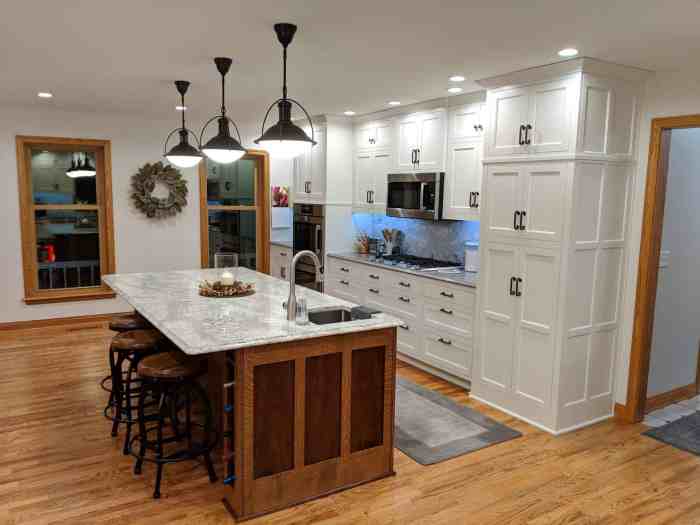
Source: customhardwoods.com
Investing in custom kitchen cabinets is a significant undertaking, and understanding the associated costs is crucial for successful planning and execution. Several factors influence the final price, ranging from the materials chosen to the intricacy of the design and the labor involved. Careful budgeting is essential to avoid unexpected expenses and ensure a smooth renovation process.
Factors Influencing Custom Cabinet Costs
The cost of custom kitchen cabinets is a multifaceted issue. Material selection significantly impacts the price. Solid wood, such as cherry or maple, is more expensive than less expensive options like medium-density fiberboard (MDF). The complexity of the design also plays a role; intricate details, multiple finishes, and specialized features like curved doors or extensive molding add to the overall cost.
Labor costs vary depending on the cabinet maker’s experience, location, and the time required for design, construction, and installation. Finally, the size of the kitchen directly influences the overall cost, with larger kitchens requiring more cabinets and, therefore, incurring higher expenses.
Pricing Structures for Custom Cabinets, Custom Kitchen Cabinets
Cabinet makers typically employ various pricing structures. One common method is pricing per linear foot, which calculates the cost based on the total length of the cabinets. This method is relatively straightforward but may not accurately reflect the complexity of individual cabinets. Another approach is per-cabinet pricing, where each cabinet is priced individually based on its size, design, and materials.
This offers a more detailed cost breakdown but can be more complex to calculate. Some cabinet makers also offer package deals, which bundle cabinets, countertops, and installation for a fixed price. It’s essential to understand the specific pricing structure used by your chosen cabinet maker to accurately assess the total cost.
Sample Budget Breakdown for a Medium-Sized Kitchen Renovation
The following table provides a sample budget breakdown for a medium-sized kitchen renovation (approximately 10 linear feet of cabinets). Remember that these are estimates, and actual costs may vary based on location, materials, and contractor choices.
| Item | Description | Quantity | Cost per Unit | Total Cost |
|---|---|---|---|---|
| Custom Cabinets | Solid wood cabinets with standard features | 10 linear feet | $500/linear foot | $5000 |
| Cabinet Installation | Professional installation, including demolition and disposal | 1 | $2000 | $2000 |
| Countertops | Mid-range laminate countertops | 10 linear feet | $100/linear foot | $1000 |
| Hardware | Knobs, pulls, and hinges | 1 set | $200 | $200 |
| Plumbing and Electrical | Minor adjustments to existing plumbing and electrical | 1 | $500 | $500 |
| Project Management/Contingency | Allowance for unforeseen expenses and project management | 1 | $800 | $800 |
| Total Estimated Cost | $10,500 |
Conclusive Thoughts: Custom Kitchen Cabinets
Designing and installing custom kitchen cabinets is a significant undertaking, but the result—a kitchen perfectly tailored to your lifestyle and preferences—is well worth the effort. From the initial design consultation to the final installation, careful planning and consideration of materials, styles, and budget are paramount. Remember to visualize your ideal kitchen, research your options thoroughly, and don’t hesitate to seek professional advice to ensure a smooth and successful renovation.
Your dream kitchen awaits!
Expert Answers
What’s the average lifespan of custom kitchen cabinets?
With proper care, high-quality custom cabinets can last 20-50 years or even longer.
How long does the entire custom cabinet process take?
The timeline varies greatly depending on design complexity and the cabinet maker’s workload, but expect several weeks to several months.
Can I change my design mid-process?
Generally, yes, but changes later in the process may incur additional costs and delays.
What are some common cabinet construction mistakes to avoid?
Poorly planned storage, inadequate ventilation, and neglecting durable materials are common pitfalls.
How do I clean different cabinet finishes?
Cleaning methods vary depending on the finish (paint, stain, lacquer). Always test a cleaning solution in an inconspicuous area first.

